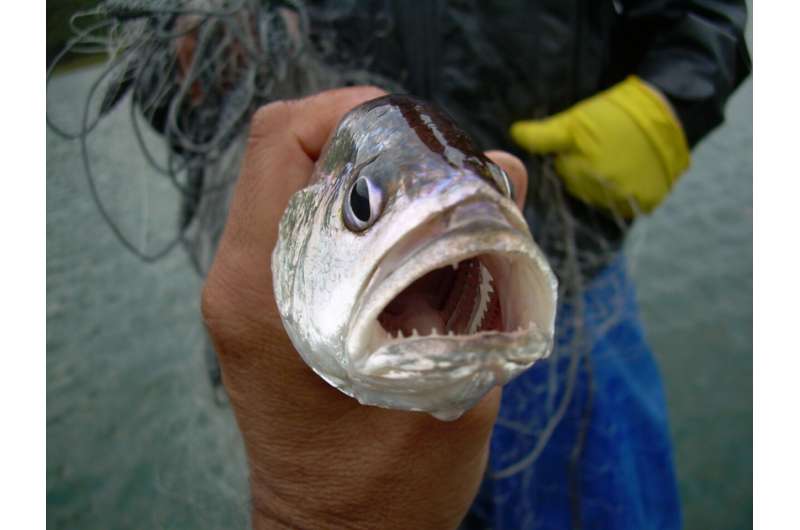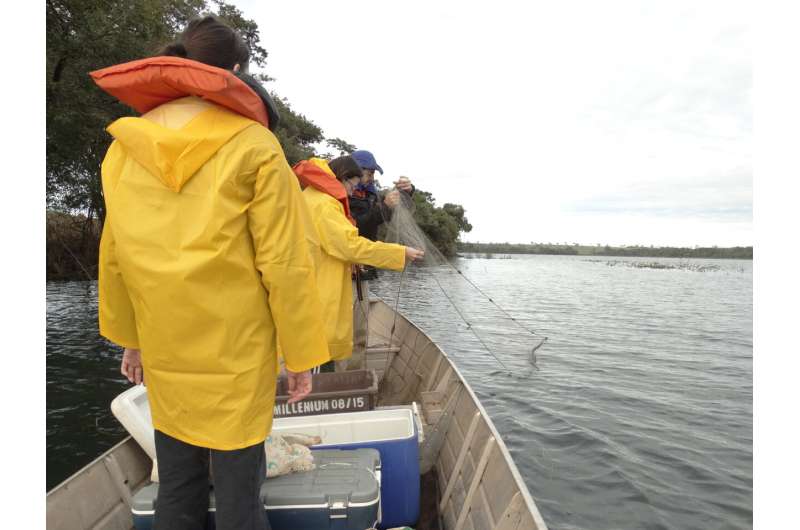This article has been reviewed according to Science X's editorial process and policies. Editors have highlighted the following attributes while ensuring the content's credibility:
fact-checked
peer-reviewed publication
trusted source
proofread
In a reservoir in Southeast Brazil, introduction of a fish native to the Amazon has reduced native species diversity

The silver croaker (Plagioscion squamosissimus), a fish native to the Amazon (corvina or pescada-branca in Portuguese), is the most probable cause of a sharp fall in the diversity of native species in the Jaguari reservoir, the Jaguari River and Rio do Peixe, all of which are part of the Cantareira Water Production System and the Paraíba do Sul Basin in São Paulo state, Brazil.
As a top predator in the food network, the invader has negatively affected local biodiversity by bringing about detrimental changes to its taxonomic, functional and phylogenetic structure, according to a study published in Biological Invasions by researchers at São Paulo State University (UNESP).
They analyzed fish monitoring data collected by power utility CESP (Companhia Energética de São Paulo), which has recorded the presence of the species in the reservoir since 2001. The data analyzed is for a period ending in 2016. In no more than ten years, P. squamosissimus has become the most abundant fish species in the reservoir.
"Although this predator is widely distributed in hydroelectric dam reservoirs throughout Brazil, its potential effects on native species had never been studied before. Our analysis highlights considerable losses to fish species diversity in the region," said Aymar Orlandi Neto, first author of the article. Conducted at the Ilha Solteira School of Engineering (FEIS-UNESP), the study was part of his Ph.D. research at the Botucatu Institute of Biosciences (IBB-UNESP). Some of the results were obtained while he was doing research at the University of Valencia in Spain.
CESP does this monitoring of fauna to comply with environmental licensing rules for operation of the dam and power plant enforced by IBAMA, the main federal environmental agency. Every four months its technicians install nets at predetermined locations in the reservoir (between Jacareí and São José dos Campos) and on the Peixe and Jaguari, identify the species caught, and estimate their abundance.
"We analyzed 15 years of monitoring data and found the abundance of native predators, particularly the thin dogfish (Oligosarcus hepsetus), to have declined significantly as P. squamosissimus preyed on smaller fish and became more abundant," said Igor Paiva Ramos, last author of the article and a professor at FEIS-UNESP.
However, it is not possible to tell from the available data whether the decline of O. hepsetus was due to indirect competition, since both this species and the invader may prey on the same fish. Another possibility is that P. squamosissimus, which can reach 80 cm, preyed on O. hepsetus, which is much smaller (30 cm as an adult). The former typically inhabits standing water bodies, such as lakes, and has thrived in the reservoir; whereas O. hepsetus, the native predator, prefers running water.
Introduced species
Invader species are a global problem and occur in environments of all kinds, on land and in water. In Brazil, the annual damage caused by non-native animals, plants and microorganisms has been estimated at BRL 15 billion (now about US $2.9 billion).

The figure is from the Thematic Report on Invasive Exotic Species, Biodiversity and Ecosystem Services, launched in March by the Brazilian Platform on Biodiversity and Ecosystem Services (BPBES).
In the article on the UNESP study, the researchers stress that other introduced species appear in the records for the Jaguari reservoir, including the peacock bass (Cichla spp.), also native to the Amazon, and Oreochromis niloticus and Coptodon rendalli, both of which are tilapias and originally from Africa, but their numbers are very small, reinforcing the conclusion that native diversity has dwindled due to P. squamosissimus.
The diversity loss observed by the authors applies to all three dimensions considered when this type of impact is assessed—taxonomic, functional and phylogenetic. Species richness losses during the period analyzed were noted, alongside substitution of many rare specialist species by a few generalists, and significant differences were found in species composition and abundance in the local fish community, with entire evolutionary groups disappearing.
Social problems
There are no simple solutions to the problem. The species is seen as a key fishing resource for both subsistence and sport. Eradicating it could cause social problems.
"The species has become very common throughout Brazil. It replaces native species and now plays a very important social role in local economies," Ramos said.
Nevertheless, he proposed measures similar to those taken in other countries to deal with invader species. One such measure would be to permit hunting of this species throughout the year without size limits or a ban during the reproductive period, with the aim of eradicating it or at least reducing its abundance. However, federal and state laws restrict fishing not just of native species, which is quite right, but also of invasive species to some extent.
"This ends up perpetuating the species that are harmful to local fauna," Orlandi Neto said.
Ramos pointed out that eradication of invaders does not necessarily lead to a return of the natives. "We don't know whether another invader will take the place of P. squamosissimus if it's removed. The environment has been modified to such an extent that it may no longer be suitable for former inhabitants," he said.
More information: Aymar Orlandi Neto et al, Long-term impact of an invasive predator on the diversity of fish assemblages in a neotropical reservoir, Biological Invasions (2024). DOI: 10.1007/s10530-023-03243-9
Journal information: Biological Invasions
Provided by FAPESP



















